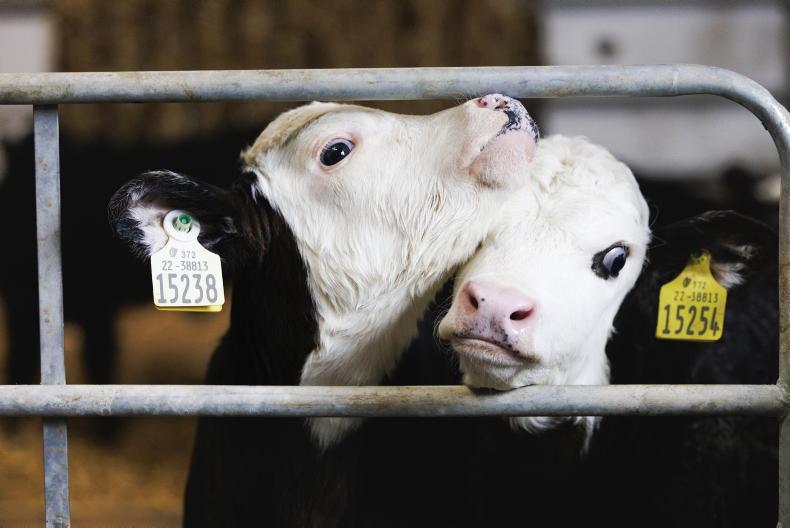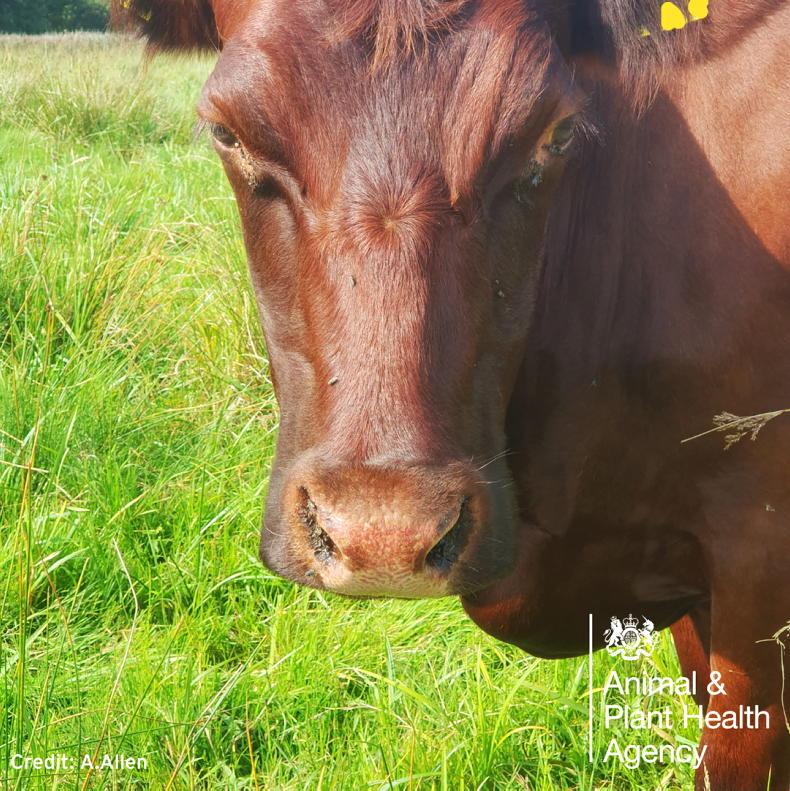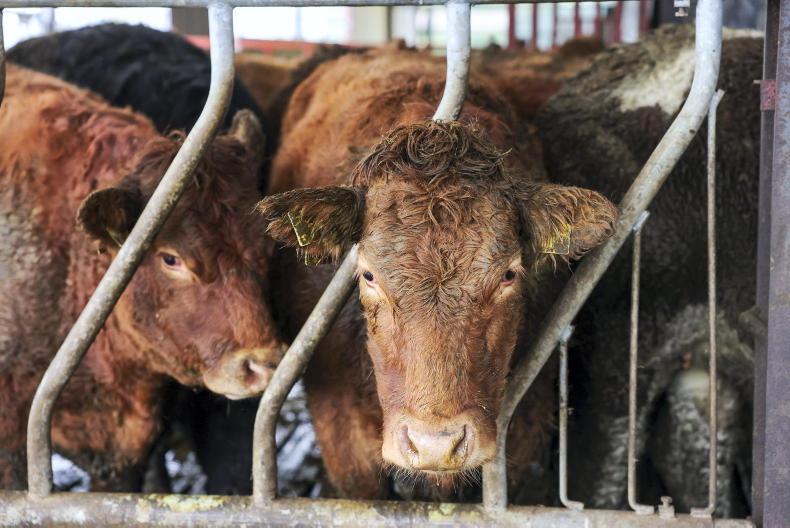Suckler farms are gearing up for the busiest two months for births on drystock farms, with calving already underway on many of them. The vast majority of cows and heifers will calve by themselves, but some will require assistance to avoid loss of the calf, and potentially the cow themselves.
It is important to understand the stages of calving, what the normal signs are for each stage, and when intervention or veterinary assistance are required. A cow gradually progresses through three stages of labour to deliver her calf.
Stage one
Calf moves into position, cervix and birth canal begin to dilate. Common signs include dropping of the pin bones, restless behaviour, raised tail head, cow making noises, full udder and mucus discharge.
Stage two
Cervix fully dilated, the calf moves through the birth canal and is eventually delivered. The calf is covered by two membranes. The outer membrane (water bag) often ruptures as it passes through the cervix, before it becomes visible. The membrane directly surrounding the calf is called the amnion and is a white-clear membrane, when compared to the darker outer membrane.
Common signs include the appearance of the inner membrane covering the calf’s legs, straining.
In normal deliveries, this stage lasts from 30 minutes to four hours, but may be longer in heifers. If a cow is moved during labour, the point at which she is moved can increase the length of labour.
A longer stage two labour is associated with increased stillbirths, calving difficulty and problems with cows post-calving. It’s all about progress at this stage, once the cow is making progress, she should be let get on with calving.
Stage three
Passing of the placenta, which normally occurs within 30 minutes to eight hours post-calving.
To help or not to help
A question that always comes up at this time of year is when to intervene and when to leave things alone and let nature do it’s business. Guidelines for making the decision to assist include:
If a cow is restless for more than four hours, but does not start straining or pushing. If a cow is straining, but no part of the calf is showing after two hours.If feet and/or nose are showing, but the calf is not delivered after two hours.If the calf is not presenting normally, ie a head back or foot down, then intervention is required. Handling the cow will tell you a few things – if the cervix has dilated properly, if the calf is dead or alive, or if the calf is presenting normally.
A normal forward “ superman” presentation, which is the typical presentation, is when the front legs and head come first and the calf is lying on its stomach (ie calf’s back next to cow’s back).
A normal backwards presentation is when the back legs are coming first, again with the calf lying on its stomach.
Never pull a calf presented in any other position. A calf that is coming backwards needs to be delivered more quickly as they can suffocate, but this may be more difficult, as the calf’s head will not have dilated the uterus.
John Quinn from Ashwood Veterinary practice in Mohill, Co Leitrim, was speaking at a livestock demo in Carrigallen Mart last Thursday night. He had some good tips on assisting at calving, including a calving checklist of items farmers should have for calving.
Calf not presenting normally
Look for landmarks that will help you identify how the calf is presenting, eg a knee or hock joint, a tail, some part of the head (if the head is facing back it might be an ear). Many of these positions can be corrected if found early in the labour process.
If there is a leg down, cup the hoof in your hand when repositioning to prevent uterine damage. If you are inexperienced, call for a veterinary practitioner, as this can be difficult. It may happen that you can’t feel any part of the calf, and if the labour has been progressing for some time, this can mean that the uterus hasn’t dilated or there is a uterine torsion and veterinary assistance will be required.

IFJ Suckler Roadshow in Longford 30 Jan 2025. Big crowds attend a informative roadshow. Local Vet Brendan Leslie demoed safe Calving practices. Emma Sargent from MSD pictured \ Claire Nash
Is the calf too big?
Determining the size of the calf relative to the birth canal is critical and requires some experience.
How easy is it to carry out a uterine exam on the cow? If this is difficult, then help should be sought from your vet.How much space is there between the calf’s head and the pelvic canal? You should be able to put your hand around the calf’s head comfortably. Not being able to get your hand in around the back of the calf’s head could be a sign of a big calf, or the cow isn’t far enough along the calving process to intervene. If the front legs are crossing, this means the space is restricted and it is unlikely there is room for the calf to be delivered. It can be a sign of big shoulders and caution is needed in terms of progressing any further. Size of the legs: back legs tend to be lighter.Sex of the calf: in general bull calves are bigger. This may have been determined at scanning time or if sexed semen was used. Sire used: some breeds have larger hips; size of previous calves from this sire is important here.Due date and stage of season: calves tend to get bigger later in the calving season. Cows on good-quality silage for a long winter are prone to this.The nutrition and body condition of the dam: fat deposits can restrict birth canal space, while a very thin cow may not have the energy to calve.Assisting the cow
If the cow can stand, get the cow into a calving gate before starting. A calving gate is an absolute necessity on any farm with suckler cows. Ensure the gate is easy to open, to prevent choking if they go down.
Place a separate rope on each of the calf’s legs above the first joint. Before applying traction, gel should be applied. Quinn said: “Don’t spare the lube at the beginning. It could be the difference in getting a big set of hips out later on.”
Pull both legs gently, with even pressure, and work with the cow’s contractions. Patience is needed, as the contractions help dilate the birth canal.
If a calving jack is being used, it’s important to remember the powerful force that it exerts on the cow. Steady and slow is the name of the game here, with no fast ratcheting of the jack taking place. Once the head is out, pull the calf out and down at a 45° angle to the cow’s spine – once the rib cage is out, the downward angle can be increased. Use the jack to gently lever the calf out and then take off the slack with the rachet.
One cause of calf death and damage to the dam is hip lock. If this happens, rotating the calf may create a new angle for the hips to pass through the cow’s pelvis. John Quinn also said that he would sometimes bring the calving jack down and out to one side, to try and create a gentle twist to prise the calf’s hips out.
If the calf has trouble breathing, clear the mouth and nose of mucus and stimulate breathing by scratching the inside of the nose with straw, placing a drop of clean cold water in its ear, rubbing each side of chest with straw, swinging the calf by the back legs, or using the calving jack in an upright position, or over a gate, to allow the calf to clear its lungs.
“You don’t need to hang the calf up for five minutes. This will actually do more harm than good. You just need it up for 10-20 seconds to clear any fluid. If a calf has had a difficult calving, a painkiller injection is important.
“Some of these big calves can get acidotic very quickly, so a stomach tube with a rehydration tablet will help. I don’t like feeding these big calves huge amounts of milk to start. I would rather see a little and often approach, and give them a chance – rather than a huge feed at the one time,” concluded John.
Suckler farms are gearing up for the busiest two months for births on drystock farms, with calving already underway on many of them. The vast majority of cows and heifers will calve by themselves, but some will require assistance to avoid loss of the calf, and potentially the cow themselves.
It is important to understand the stages of calving, what the normal signs are for each stage, and when intervention or veterinary assistance are required. A cow gradually progresses through three stages of labour to deliver her calf.
Stage one
Calf moves into position, cervix and birth canal begin to dilate. Common signs include dropping of the pin bones, restless behaviour, raised tail head, cow making noises, full udder and mucus discharge.
Stage two
Cervix fully dilated, the calf moves through the birth canal and is eventually delivered. The calf is covered by two membranes. The outer membrane (water bag) often ruptures as it passes through the cervix, before it becomes visible. The membrane directly surrounding the calf is called the amnion and is a white-clear membrane, when compared to the darker outer membrane.
Common signs include the appearance of the inner membrane covering the calf’s legs, straining.
In normal deliveries, this stage lasts from 30 minutes to four hours, but may be longer in heifers. If a cow is moved during labour, the point at which she is moved can increase the length of labour.
A longer stage two labour is associated with increased stillbirths, calving difficulty and problems with cows post-calving. It’s all about progress at this stage, once the cow is making progress, she should be let get on with calving.
Stage three
Passing of the placenta, which normally occurs within 30 minutes to eight hours post-calving.
To help or not to help
A question that always comes up at this time of year is when to intervene and when to leave things alone and let nature do it’s business. Guidelines for making the decision to assist include:
If a cow is restless for more than four hours, but does not start straining or pushing. If a cow is straining, but no part of the calf is showing after two hours.If feet and/or nose are showing, but the calf is not delivered after two hours.If the calf is not presenting normally, ie a head back or foot down, then intervention is required. Handling the cow will tell you a few things – if the cervix has dilated properly, if the calf is dead or alive, or if the calf is presenting normally.
A normal forward “ superman” presentation, which is the typical presentation, is when the front legs and head come first and the calf is lying on its stomach (ie calf’s back next to cow’s back).
A normal backwards presentation is when the back legs are coming first, again with the calf lying on its stomach.
Never pull a calf presented in any other position. A calf that is coming backwards needs to be delivered more quickly as they can suffocate, but this may be more difficult, as the calf’s head will not have dilated the uterus.
John Quinn from Ashwood Veterinary practice in Mohill, Co Leitrim, was speaking at a livestock demo in Carrigallen Mart last Thursday night. He had some good tips on assisting at calving, including a calving checklist of items farmers should have for calving.
Calf not presenting normally
Look for landmarks that will help you identify how the calf is presenting, eg a knee or hock joint, a tail, some part of the head (if the head is facing back it might be an ear). Many of these positions can be corrected if found early in the labour process.
If there is a leg down, cup the hoof in your hand when repositioning to prevent uterine damage. If you are inexperienced, call for a veterinary practitioner, as this can be difficult. It may happen that you can’t feel any part of the calf, and if the labour has been progressing for some time, this can mean that the uterus hasn’t dilated or there is a uterine torsion and veterinary assistance will be required.

IFJ Suckler Roadshow in Longford 30 Jan 2025. Big crowds attend a informative roadshow. Local Vet Brendan Leslie demoed safe Calving practices. Emma Sargent from MSD pictured \ Claire Nash
Is the calf too big?
Determining the size of the calf relative to the birth canal is critical and requires some experience.
How easy is it to carry out a uterine exam on the cow? If this is difficult, then help should be sought from your vet.How much space is there between the calf’s head and the pelvic canal? You should be able to put your hand around the calf’s head comfortably. Not being able to get your hand in around the back of the calf’s head could be a sign of a big calf, or the cow isn’t far enough along the calving process to intervene. If the front legs are crossing, this means the space is restricted and it is unlikely there is room for the calf to be delivered. It can be a sign of big shoulders and caution is needed in terms of progressing any further. Size of the legs: back legs tend to be lighter.Sex of the calf: in general bull calves are bigger. This may have been determined at scanning time or if sexed semen was used. Sire used: some breeds have larger hips; size of previous calves from this sire is important here.Due date and stage of season: calves tend to get bigger later in the calving season. Cows on good-quality silage for a long winter are prone to this.The nutrition and body condition of the dam: fat deposits can restrict birth canal space, while a very thin cow may not have the energy to calve.Assisting the cow
If the cow can stand, get the cow into a calving gate before starting. A calving gate is an absolute necessity on any farm with suckler cows. Ensure the gate is easy to open, to prevent choking if they go down.
Place a separate rope on each of the calf’s legs above the first joint. Before applying traction, gel should be applied. Quinn said: “Don’t spare the lube at the beginning. It could be the difference in getting a big set of hips out later on.”
Pull both legs gently, with even pressure, and work with the cow’s contractions. Patience is needed, as the contractions help dilate the birth canal.
If a calving jack is being used, it’s important to remember the powerful force that it exerts on the cow. Steady and slow is the name of the game here, with no fast ratcheting of the jack taking place. Once the head is out, pull the calf out and down at a 45° angle to the cow’s spine – once the rib cage is out, the downward angle can be increased. Use the jack to gently lever the calf out and then take off the slack with the rachet.
One cause of calf death and damage to the dam is hip lock. If this happens, rotating the calf may create a new angle for the hips to pass through the cow’s pelvis. John Quinn also said that he would sometimes bring the calving jack down and out to one side, to try and create a gentle twist to prise the calf’s hips out.
If the calf has trouble breathing, clear the mouth and nose of mucus and stimulate breathing by scratching the inside of the nose with straw, placing a drop of clean cold water in its ear, rubbing each side of chest with straw, swinging the calf by the back legs, or using the calving jack in an upright position, or over a gate, to allow the calf to clear its lungs.
“You don’t need to hang the calf up for five minutes. This will actually do more harm than good. You just need it up for 10-20 seconds to clear any fluid. If a calf has had a difficult calving, a painkiller injection is important.
“Some of these big calves can get acidotic very quickly, so a stomach tube with a rehydration tablet will help. I don’t like feeding these big calves huge amounts of milk to start. I would rather see a little and often approach, and give them a chance – rather than a huge feed at the one time,” concluded John.











SHARING OPTIONS